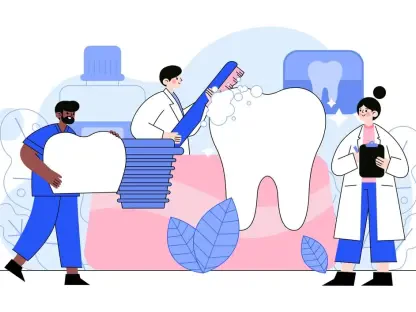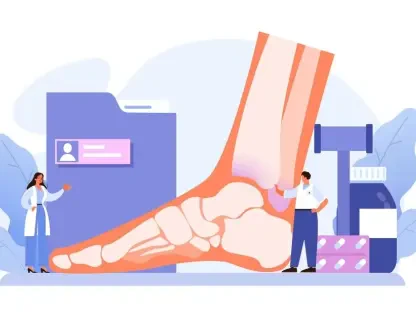Setting the Stage for a Data-Driven Healthcare Revolution
Imagine a healthcare system where artificial intelligence (AI) seamlessly personalizes patient care, predicts health risks with pinpoint accuracy, and streamlines hospital operations—all while cutting costs. This vision is within reach, yet it hinges on a less glamorous but critical component: the quality of customer relationship management (CRM) data. In healthcare, where decisions can mean life or death, poor data quality has led to staggering losses, with industry reports indicating that 44% of organizations have faced direct revenue declines due to unreliable datasets. This review delves into the technology of CRM data harmonization, exploring how it underpins AI’s transformative potential in healthcare and why it remains a pressing challenge in fragmented medical systems.
The significance of harmonized CRM data cannot be overstated as AI adoption accelerates across healthcare sectors. This technology ensures that disparate datasets—spanning patient demographics, medical histories, and billing records—are cleaned, standardized, and unified to train reliable AI models. Without such a foundation, even the most advanced algorithms risk producing biased or inaccurate outputs, undermining trust in digital health solutions. This analysis aims to unpack the intricacies of CRM data harmonization, spotlighting its features, real-world performance, and the hurdles that must be overcome.
Unpacking the Core Features of CRM Data Harmonization
Data Cleaning and Standardization: Building a Reliable Base
At the heart of CRM data harmonization lies the meticulous process of data cleaning, which tackles inconsistencies, missing entries, and errors in healthcare datasets. This step is vital to eliminate noise that could skew AI predictions, such as duplicate patient records or mismatched medical codes. By ensuring accuracy at the granular level, cleaning sets the stage for AI systems to deliver meaningful insights without the risk of misinterpretation.
Standardization complements cleaning by aligning data formats and measurement units across diverse sources. For instance, converting varied date formats or unifying clinical terminology ensures that AI models interpret information consistently. This uniformity is not just a technical necessity but a safeguard against flawed outputs that could impact patient care. Without standardized data, even robust algorithms struggle to make sense of fragmented inputs, highlighting the indispensable role of this feature.
Data Consolidation: Bridging Fragmented Systems
Healthcare systems, particularly in the United States, often operate in silos, with data scattered across multiple platforms and institutions. Data consolidation addresses this fragmentation by integrating information from electronic health records, insurance databases, and other repositories into a cohesive dataset. This unified view is essential for AI to generate comprehensive analyses, whether for predicting patient outcomes or optimizing resource allocation.
However, achieving consolidation is no small feat, given the technical and systemic barriers involved. Differing software protocols and privacy regulations complicate the merging of datasets, often requiring sophisticated integration tools. Despite these challenges, successful consolidation enhances AI performance by providing a fuller picture of patient interactions, ultimately driving better decision-making in clinical and administrative contexts.
Performance in the Real World: Impact and Limitations
Enhancing AI-Driven Healthcare Outcomes
When implemented effectively, CRM data harmonization transforms healthcare AI applications, enabling personalized patient engagement and operational efficiency. Clean, unified data allows algorithms to tailor treatment plans based on individual medical histories and predict health trends with greater accuracy. For example, some hospitals have used harmonized datasets to reduce readmission rates by identifying at-risk patients early, showcasing the technology’s tangible benefits.
Beyond clinical applications, harmonized data streamlines administrative processes like billing and insurance claims. By minimizing errors in financial records, healthcare providers can avoid costly disputes and focus resources on patient care. Industry insights reveal that organizations leveraging high-quality CRM data often see improved financial outcomes, underscoring the technology’s broader value in a sector under constant economic pressure.
Facing the Challenges of Fragmentation and Technical Barriers
Despite its promise, CRM data harmonization grapples with significant limitations, primarily due to the fragmented nature of healthcare systems. Inconsistent data collection practices and varying storage methods create gaps that hinder comprehensive integration, especially in regions with decentralized medical infrastructures. These systemic issues often result in incomplete datasets that undermine AI reliability.
Technical obstacles further complicate the process, as disparate formats and outdated systems resist easy harmonization. While modern tools and policies aim to address these hurdles, progress remains uneven, with smaller providers often lacking the resources to adopt advanced solutions. This disparity highlights a critical performance gap, as the benefits of harmonized data are not yet universally accessible across the healthcare landscape.
Current Trends and Industry Recognition
Growing Emphasis on Data Integrity
A notable trend in the healthcare AI space is the increasing acknowledgment of data integrity as a prerequisite for successful technology deployment. Authorities like the UK National Health Service have issued guidance emphasizing that poor-quality data can introduce biases and errors into AI outputs. This recognition marks a shift toward prioritizing foundational data practices over mere algorithmic advancements, a perspective gaining traction globally.
Interestingly, the discourse around data harmonization often takes a backseat to discussions of AI performance metrics. Experts argue that this oversight is problematic, as the quality of input directly dictates output reliability. The push for broader conversations about ethical data usage reflects an evolving understanding that transparency in data handling is crucial, especially in sensitive fields like healthcare.
Innovations on the Horizon
Looking ahead, emerging tools for data integration promise to simplify harmonization efforts, with automated platforms reducing manual cleaning and standardization tasks. These innovations aim to bridge gaps in fragmented systems, offering scalable solutions for providers of all sizes. Over the next few years, from 2025 onward, advancements in interoperability standards are expected to further enhance the technology’s reach and effectiveness.
Additionally, policy reforms are gaining momentum to support standardized data protocols, addressing systemic barriers at a structural level. Collaborative efforts between tech developers and healthcare stakeholders are fostering environments where harmonized CRM data can thrive. These trends suggest a maturing field poised to tackle long-standing challenges with renewed focus and ingenuity.
Reflecting on the Journey and Charting the Path Forward
Looking back, the exploration of CRM data harmonization revealed a technology that stands as a linchpin for AI’s success in healthcare, despite facing formidable obstacles. Its capacity to clean, standardize, and consolidate disparate datasets proved essential in powering accurate and unbiased AI models, while real-world applications demonstrated measurable improvements in patient care and operational outcomes. Yet, the persistent challenges of systemic fragmentation and technical disparities underscored that the journey toward universal adoption is far from complete.
Moving forward, healthcare organizations must prioritize investment in integration tools and training to bridge existing gaps, ensuring that even smaller providers can harness the benefits of harmonized data. Collaborative initiatives between policymakers, technologists, and medical professionals should focus on establishing universal data standards to dismantle systemic silos. By committing to these actionable steps, the industry can build a robust foundation for AI, paving the way for a future where technology and healthcare intersect to deliver equitable, data-driven solutions.









